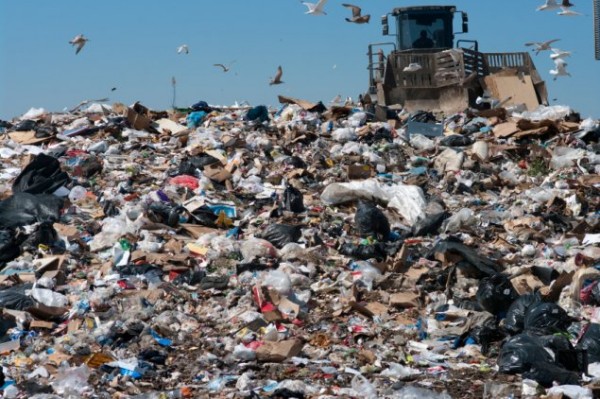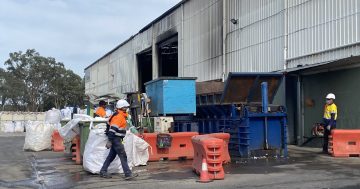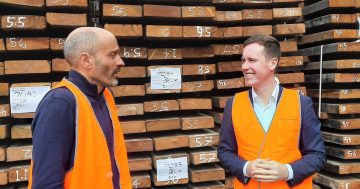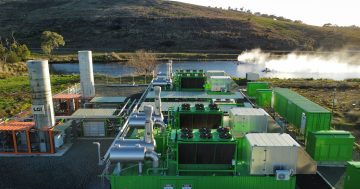A proposal to build a $200 million combined waste to energy and recycling plant in Fyshwick promises to solve Canberra’s looming landfill problem and produce base-load electricity to power 28,000 homes.
But it is already striking resistance from the ACT Conservation Council which believes the ACT Government should be focusing on more extensive recycling and composting efforts to reduce landfill not create an incentive for more waste. There were also concerns about emissions.
The Inner South Canberra Community Council also plans to hold a public meeting next month and meet the proponents.
Capital Recycling Solutions Pty Limited (CRS) plans to build the facility for recycling, resource recovery and renewable energy on industrial land it already owns in Ipswich Street adjacent to the rail line, which also plays a significant role in the proposal.
It would take domestic and industrial waste primarily from the ACT but also from the surrounding region in NSW and sort it into recyclable streams with the remaining waste converted into electricity through ‘thermal combustion technology’.
CRS is a joint venture between Sydney-based Benedict Industries Pty Ltd and Access Trading Company Pty Ltd (Access Recycling), which has operations in Canberra. It has a memorandum of understanding with ActewAGL to sell electricity into the grid.
Project manager Ewen McKenzie, a former Wallaby and Australian rugby coach, said the facility would employ 60 people and the process was as much a closed loop as possible.
“You take unprocessed waste going direct to landfill, process it, extract what we can from a recycling point of view, use the residue for thermal conversion, get the benefit of baseload electricity, and then after that you get another chance at the recycling with the more metals, and some of the ash can be recycled,” he said.

He said the plant would use proven technology used in Europe, where the decision was made decades ago to reduce landfill through a combination of waste to energy and recycling. More than 400 such plants operated in Europe, he said.
The diversion from landfill would also reduce greenhouse gas emissions from methane.
“Moving away from landfill is happening in other countries and that’s the direction here in Australia,” he said.
ACT Conservation Council executive director Larry O’Loughlin agreed landfill was finite but said there was still time to further educate the community on waste and develop more strategies to reduce waste, accusing the Government of lacking leadership.
“Let’s reduce our waste, let’s take products out of the waste stream, let’s provides some facilities for the community, a third bin [for food scraps] or something like that,” he said.
He said any facility would have to be built larger than needed to cater for projected growth.
It would also emit greenhouse gases and possibly toxic materials like dioxins depending on the technology used. “There’s no way you can’t have CO2 or greenhouse gases if you are burning,” he said. “If you’re burning plastic, unless you’re really careful you are going to produce some nasties, like dioxins, but those things can be managed to a point.”
He said there was no detail on the technology CRS would use and at present it was just a proposal.
“We’ll be meeting with and talking to the proponents. We’ll talk with the Government, which should be producing a policy on waste to energy like NSW, in the context of our commitment to zero net emissions.”
Mr McKenzie said that while the facility would draw on the region the focus was “to set this up for Canberra”.
“The Government has various targets, and we think we can line up on the landfill side and also on the renewable energy side, ” he said.
The facility would have a capacity for 400,000 tonnes of waste, taking about 90 per cent of the 390,000 tonnes that go to Mugga Lane Resource Management Centre annually, with the balance from NSW.
No change is anticipated to current arrangements for kerbside pickup or to the yellowtop recycling bins but trucks would take their loads to Fyshwick instead of Mugga Lane.
Mr McKenzie, who visited Canberra last week to meet businesses and some residents, was confident that any concerns about air quality, emissions and odour could be allayed.
The nearest residential area is the Canberra South Motor Park in North Symonston (560 metres from the chimney stack). The nearest house is in Matina Street, Narrabundah (820 metres).
Mr McKenzie said burning was too simple a word for the waste to energy process.
“Call it want you want but if you going to use combustion create heat, drive turbines, manage emission control, create potential reusable ash, more metal, electricity, it’s a little bit more sophisticated than that,” he said.
He said the types of emission control equipment was already proven, meeting the European standards which are the world’s toughest.
The company’s scoping study says a live-feed website will display emissions data in continuous real time for the community to observe and monitor.
Odour would be contained within the facility. “The trick is to do your activity inside a building where negative air pressure environment stops it leaving,” he said.
The proposal also promises to take trucks off the road by rejuvenating the area’s rail assets and using the line to transport waste and materials into Canberra and export recyclables out.
The facility would not be stockpiling material. “Were not set up for that, we want to move stuff, so creating efficiencies in that area is important,” he said.
Mr McKenzie said the rail line was one of the reasons the company chose the site and there had been a positive response from Canberra businesses that could benefit from a renewed freight service.
The Environment, Planning and Sustainable Development Directorate said the ACT planning and land authority would soon begin an Environmental Impact Statement (EIS) process for the proposed centre.
Mr McKenzie said the EIS and a health assessment would take a few months and the company’s community engagement program would be ongoing. The scoping paper says considerable community opposition to the proposal is expected.
The chair of the Inner South Canberra Community Council, Marea Fatseas, said the council was liaising with all the affected residents groups to organise a public meeting in August to discuss the proposal, as well as seeking more information from the proponent.
The Directorate said the draft EIS would be released for public consultation in the coming months. More information will be released at that time and made available at www.planning.act.gov.au
The company’s scoping study can be viewed at Capital Recycling Solutions.















